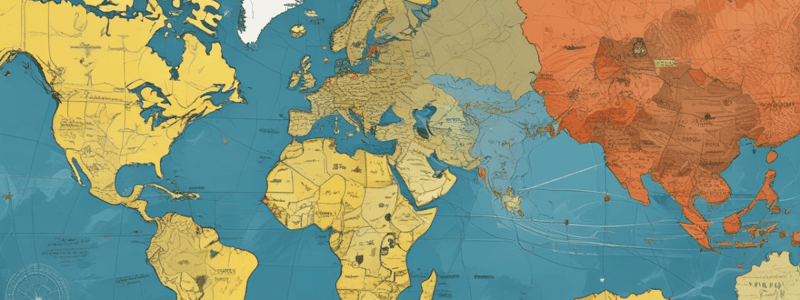Podcast
Questions and Answers
What is the assumption in much of the literature on nuclear deterrence?
What is the assumption in much of the literature on nuclear deterrence?
- Nuclear weapons deter both nuclear and conventional conflict (correct)
- Nuclear weapons do not deter any kind of conflict
- Nuclear weapons only deter nuclear conflict
- Nuclear weapons only deter conventional conflict
What is the main difference between regional nuclear powers and the US-USSR in terms of their nuclear forces?
What is the main difference between regional nuclear powers and the US-USSR in terms of their nuclear forces?
- The number of nuclear weapons they possess
- The geostrategic situation of their nuclear forces
- The type of nuclear weapons they possess
- The financial and technical limits of their nuclear forces (correct)
What is the focus of Narang's research on regional nuclear powers?
What is the focus of Narang's research on regional nuclear powers?
- How to allocate nuclear forces for deterrence against both conventional and nuclear opponents (correct)
- How to allocate nuclear forces for deterrence against conventional opponents
- How to reduce nuclear arsenals for regional stability
- How to configure nuclear capabilities for maximum deterrence
Which of the following is NOT a characteristic of regional nuclear powers?
Which of the following is NOT a characteristic of regional nuclear powers?
What is the central question of Narang's research?
What is the central question of Narang's research?
What is the primary factor that distinguishes different nuclear postures?
What is the primary factor that distinguishes different nuclear postures?
According to Narang, what is the consequence of having a catalytic posture?
According to Narang, what is the consequence of having a catalytic posture?
What is the goal of an assured retaliation posture?
What is the goal of an assured retaliation posture?
What is the effect of asymmetric escalation on the space for conflict?
What is the effect of asymmetric escalation on the space for conflict?
What is the relationship between a state's nuclear posture and the credibility of its threat to use nuclear weapons?
What is the relationship between a state's nuclear posture and the credibility of its threat to use nuclear weapons?
What is the role of third-party intervention in a catalytic posture?
What is the role of third-party intervention in a catalytic posture?
What is the concept of 'general nuclear compellence' according to Anderson et al?
What is the concept of 'general nuclear compellence' according to Anderson et al?
According to Narang 2015, what drives states' choice of nuclear postures?
According to Narang 2015, what drives states' choice of nuclear postures?
What is the 'stability-instability paradox' in the context of deterrence theory?
What is the 'stability-instability paradox' in the context of deterrence theory?
What is the main difference between 'nuclear posture' and 'nuclear strategy'?
What is the main difference between 'nuclear posture' and 'nuclear strategy'?
What is 'existential deterrence'?
What is 'existential deterrence'?
What is the main goal of 'immediate compellence'?
What is the main goal of 'immediate compellence'?
What is the military imbalance between Israel and its Arab neighbors, and how does it affect Israel's security situation?
What is the military imbalance between Israel and its Arab neighbors, and how does it affect Israel's security situation?
What kind of security guarantees did Israel repeatedly request from Washington, and what was the response?
What kind of security guarantees did Israel repeatedly request from Washington, and what was the response?
What public statement did President Kennedy make about the US commitment to Israel's security, and what did it signify?
What public statement did President Kennedy make about the US commitment to Israel's security, and what did it signify?
How did Israel's nuclearization affect the risks of nuclear escalation in the Middle East?
How did Israel's nuclearization affect the risks of nuclear escalation in the Middle East?
What was the primary concern of the United States regarding Israel's security?
What was the primary concern of the United States regarding Israel's security?
What was the outcome of the increased material commitments to Israeli security by the United States?
What was the outcome of the increased material commitments to Israeli security by the United States?
By what year was Israel widely considered a nuclear-weapons state?
By what year was Israel widely considered a nuclear-weapons state?
How did the United States' position on Israel's security change over time?
How did the United States' position on Israel's security change over time?
According to historian Avner Cohen, what was the primary driver of the change in US security commitment to Israel?
According to historian Avner Cohen, what was the primary driver of the change in US security commitment to Israel?
Flashcards are hidden until you start studying
Study Notes
General Compellence and Nuclear Strategies
- The typology of nuclear strategies is shaped by U.S. policies and debates during the Cold War.
- Understanding nuclear postures of regional powers is crucial for analyzing their potential for deterrence in conflicts.
- Central question: What type of nuclear force effectively deters both conventional and nuclear threats?
- Assumptions exist that nuclear weapons deter both nuclear and conventional conflicts, but this is debated among scholars.
Importance of Regional Nuclear Powers
- Regional nuclear powers, like China, France, India, Israel, Pakistan, and South Africa, maintain independent forces of fewer than several hundred warheads.
- Unlike superpowers, these states face financial and technical limitations, forcing them to strategically allocate their nuclear capabilities.
- These nations have learned from the U.S.-Soviet experiences, enabling a more tailored approach to their deterrence strategies.
Nuclear Posture and Deterrence
- Nuclear posture refers to how a state plans to use its nuclear capability and is defined by the intended purpose of deployment.
- Different nuclear postures create varying thresholds for conflict and credibility of nuclear threats.
Identified Nuclear Postures
- Catalytic Posture: Low likelihood of nuclear use; relies on third-party intervention; provides minimal deterrent against high-intensity conflict.
- Assured Retaliation: Aims to deter nuclear engagement but may not effectively prevent conventional attacks.
- Asymmetric Escalation: Compresses conflict space; limited conventional actions may quickly lead to nuclear engagement.
Key Concepts
- Existential Deterrence: The notion that the mere possession of nuclear weapons deters aggression.
- Stability-Instability Paradox: A situation where overall stability exists due to nuclear deterrence, but lower-level conflicts may arise.
- General Compellence vs. Immediate Deterrence: General compellence involves using nuclear threats to influence a state's behavior, while immediate deterrence focuses on preventing specific aggressive actions.
Findings and Discussions
- The choice of nuclear posture is driven by a state's strategic goals and the nature of its regional threats.
- The relationship between nuclear posture, force balance, interests, and nuclear danger is complex and requires nuanced analysis.
- Debate exists on the applicability of Narang’s framework to states like Iran and North Korea, which may have different strategic considerations.
U.S. Commitment to Israeli Security
- Regional imbalances in power often favor adversarial states against Israel, which has led to Israeli nuclearization.
- The U.S. historically provided material support to Israel, weighed by concerns of nuclear reliance.
- Israeli nuclear capabilities altered U.S. security commitments, prompting deeper involvement in the region during conflicts.
Key Terms Review
- Command and Control: Systems managing nuclear weapons and decision-making authority.
- Civil-Military Relations: The interplay between civilian government and military authority in nuclear strategy.
- Causation vs. Correlation: Understanding the distinction between direct causes of state behavior versus coincidental relationships.
Studying That Suits You
Use AI to generate personalized quizzes and flashcards to suit your learning preferences.




